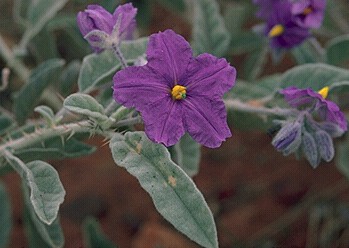
Synonymy
Solanum chippendalei Symon, J. Adelaide Bot. Gard. 4: 272; figs 119, 122 (1981)
T: Sir Frederick Range, W.A., 1 Aug. 1962, D.E. Symon 2272; holo: AD ex ADW; iso: AD, CANB, PERTH.
[S. melanospermum auct. non F. Muell.; G. Chippendale, Trans. & Proc. Roy. Soc. S. Austral. 83: 202 (1960)]
[S. phlomoides auct. non Cunn. ex Benth.; A.J. Ewart & E. Davies, Fl. N. Terr. 243 (1917)]
This species has recently been split in two with Qld collections being referred to a new species S. succosum - see Bean & Albrecht (2008) in Austrobaileya 7: 669.
Description
Erect or spreading subshrub to 1 m, usually grey-green, densely pubescent with stellate hairs; prickles to 10 mm long, common on stems, and on pedicel and calyx of bisexual flower, scattered to absent elsewhere.
Leaves ovate; lamina 4-7 cm long, 2-4 cm wide, concolorous, shallowly lobed to entire ; petiole 10-15 mm long.
Inflorescence of one bisexual flower below cyme of many male flowers, peduncle to 5 mm long; rachis to 10 cm long. Bisexual flower: pedicels mostly 10-15 mm long, lengthened in fruit; calyx usually 15-24 mm long, the lobes linear, 10-15 mm long, lengthened in fruit; corolla broadly stellate to rotate-pentagonal, 30-35 mm diam., purplish; anthers 5-6 mm long. Male flowers: pedicels to 10 mm long; calyx 10-15 mm long, the lobes narrowly triangular, 5-10 mm long; corolla stellate, 20-25 mm diam., purple; anthers 4.5-6 mm long.
Berry ovoid or globular, 20-30 mm diam., pale yellow; fruiting pedicels 25-45 mm long; fruiting calyx-lobes 20-25 mm long. Seeds 3-3.5 mm long, black. n=12.
From Flora of Australia 29: 165 (1982).
A detailed description of this species by A.R.Bean can be found at http://delta-intkey.com/solanum/www/chippend.htm
Distribution and ecology
Widespread in N.T., extending to central W.A. and central-western Qld although Bean & Albrecht (Austrobaileya) now refer more easterly occurrences to a new species, S. succosum.
Common name
Bush tomato
Relationships
An andromonoecious species i.e. one in which there are male flowers and bisexual flowers on the one plant. Often there are many male flowers in an inflorescence with 1(-2) bisexual flowers at their base. In this case only the lowest flower, which is bigger and pricklier than the rest of the male flowers above it in the inflorescence, develops into a fruit.
Andromonoecious species of the Dioicum group in Australia include S. beaugleholei, S. clarkiae, S. chippendalei, S. diversiflorum, S. eburneum, S. heteropodium, S. melanospermum, S. oedipus and S. phlomoides .
Symon (1981) indicated that S. chippendalei was most closely related to the other andromonoecious species, S. beaugleholei, S. phlomoides and S. melanospermum . The DNA studies of Martine et al. (2006) indicate that S. chippendalei, together with S. diversiflorum, S. beaugleholei, S. phlomoides, and probably S. eburneum, formed one of three clades for the andromonoecious species of the Dioicum group of subgen. Leptostemonum.
However further molecular analysis involving the trnK-matK gene region has now indicated that all of the Australian andromonoecious species (except for S. campanulatum , S. cinereum and S. stupefactum ) should be combined to form a single clade which also includes two African andromonoecious species and the Australian hermaphrodite species S. hoplopetalum (Martine et al., 2009).
References: Martine, C.T., D. Vanderpool, G.J. Anderson, and D.H. Les (2006). Phylogenetic relationships of andromonoecious and dioecious Australian species of Solanum subgenus Leptostemonum section Melongena: Inferences from ITS sequence data. Systematic Botany 31: 410-420; Martine, C.T., G.J. Anderson & D.H. Les (2009). Gender-bending aubergines; molecular phylogenetics of cryptically dioecious Solanum in Australia. Australian Systematic Botany 22: 107-120.
Notes
Important food plant of Aborigines; treated fruit eaten fresh or dried. See P. Latz, Bushfires & Bushtucker, IAD Press, Alice Springs (1995) for an expanded account of its use by the people of central Australia.
Information on the food composition of the fruit of S. chippendalei can be accessed through the NUTTAB 2006 (Nutrient Tables for use in Australia) database of the Food Standards Australia New Zealand.
Leaves are variable; deeply-lobed specimens approach S. melanospermum F. Muell., entire specimens approach S. phlomoides Cunn. ex Benth. Also closely related to S. beaugleholei Symon. Compare also with the newly recognised S. succosum.
Germination studies for mine regeneration or the native food industry indicated that germination of seed of this species is promoted with gibberellic acid. Whether the study was conducted on S. chippendalei or the newly described S. succosum is not certain but specimens came from the Great Sandy Desert.
Derivation of epithet
Named after Mr George Chippendale, a botanist who contributed greatly to the knowledge of Northern Territory plants while based in the newly established Northern Territory Herbarium in Alice Springs from 1954 to 1966. See http://www.anbg.gov.au/biography/chippendale-george.html
Plant status, if any
Conservation status as a plant of least concern in the
From the web
Extra images of S. chippendalei can be accessed through the Bean description of this species at http://delta-intkey.com/solanum/www/chippend.htm
Further information for this species in WA can be found on the FloraBase site.



